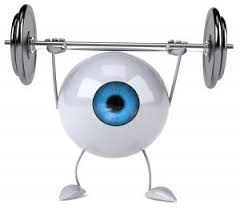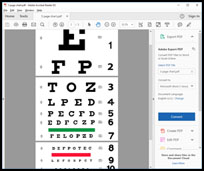People new to vision improvement may approach it looking for a quick fix. “Just tell me which exercise to do, so I can get rid of this eyesight problem and go on with my life”, they’ll say. Their problem may be poor vision in the distance, or beginning cataracts, or trouble seeing after dark, or difficulty reading the menu in restaurants. While there are common themes among those who strain their vision, one size does not fit all.
You may be “a bundle of nerves” like I used to be, anxious and trying too hard at everything. Then a relaxing practice like Palming might help, as long as you don’t strain while you’re doing it, determined to get it exactly right! (Yes, I did this myself, largely defeating the purpose of the exercise.)
Or you may be staring at a computer screen for long hours, then carrying that destructive staring habit into the rest of your life. The Long Swing vision practice can help your eyes and body relax, as you re-learn how to move easily in a natural manner. Again, you’ll need to approach the Long Swing in a playful receptive manner for it to benefit you.

The trouble with depending on a vision exercise to “fix you” is that it’s putting the emphasis in the wrong place. You are not broken! You’ve just acquired a bad habit or 2 in the way you use your eyes and brain when seeing. Bad habits can be unlearned, and you can replace them with good habits.
Going through the motions of anything, while your mind is mostly elsewhere, will get you limited benefit from it. The same is true of vision exercises. If you’re making yourself palm every day because you think you should, and spending your time during palming thinking “When will this be over so I can go do something useful?”, it won’t help you much. Instead see if you can relax into the blackness and enjoy not having to do anything, or to try to see, right now. You may need this rest more than you know.
The flexibility and strength and centered-ness you gain from a yoga practice is intended to be taken “off the mat”, to benefit the rest of your life when you’re not doing yoga. It’s the same with vision exercises. You are not doing the Long Swing to train for the Long Swing Olympics! It will become more comfortable over time as you do it more, your gaze flowing freely over your surroundings as you twist your body left and right and back to the left. And you’ll notice an increased ease in seeing throughout your day.
A vision exercise few people think about is just to take off your glasses. Can you look without straining? Please don’t drive without glasses if you need them to see well enough to be safe. Yet it’s surprising how dependent we can become on glasses, putting them on our face before we even look to see if we need them! An aid like a crutch for a broken ankle is intended to be temporary, until the body is strong enough on its own. What if glasses were the same, to be discarded when you could see well enough without them?
To answer the question I started with about which vision exercise is the best for which condition, learning to relax your mind and your seeing, and remaining aware of how you use your eyes, is more valuable than any specific exercise. You can read more about that here. As I look out the window in front of me, letting my gaze stretch past my lawn to the roof and windows and chimney across the street, I appreciate the details my eyes get to trace over: air conditioner, front steps with a mat on the landing, electric meter. Near and far, up and down, left and right. There is so much to see. What a delight!

I wore strong glasses, then contact lenses, from age 5 into my 40s. While making many mistakes, eventually l learned how to improve the way I use my eyes and to see in a more relaxed, healthy manner. It is my pleasure to coach others to do the same. Visit me at https://NancyLNeff.com.

